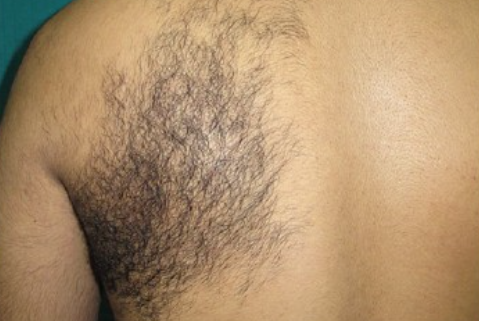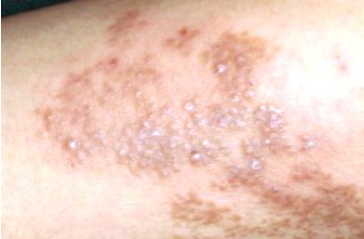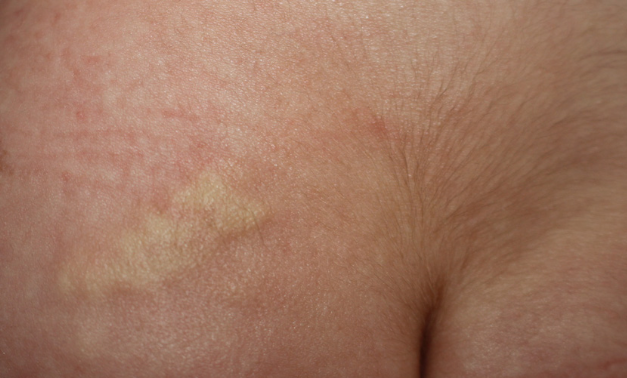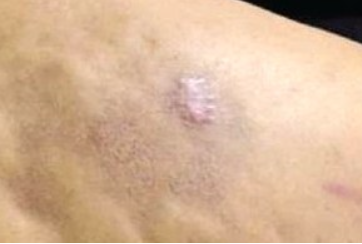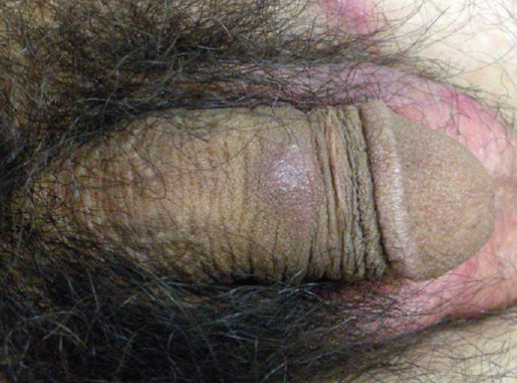Smooth muscle hamartoma is a benign skin condition histologically characterized by localized overgrowth of smooth muscle bundles in the dermis. Clinically, it appears as flesh-colored, occasionally pinkish-brown patches or flat plaques covered with light downy or long dark hairs. ICD-10 Code: Q85.9
Congenital and acquired forms of smooth muscle hamartoma are distinguished. In the vast majority of cases, the condition is congenital and occurs with a frequency of 1 in 2600 births, with a slight predominance of males over females in a ratio of 1.5:1. Almost all reported cases have been sporadic, except for rare observations of multiple hamartomas in members of the same family, suggesting a possible genetic predisposition.
The etiology and pathogenesis of this disorder remain unknown. Congenital smooth muscle hamartoma probably results from abnormal proliferation of arrector pili muscle cells during fetal mesodermal maturation. In rarer cases, proliferation of cells from the tunica dartos and blood vessels has been noted.
Some studies have shown a significant increase in the number of CD34-positive dendritic cells in the reticular dermis. It has been suggested that they may play a role in the aberrant development of the arrector pili muscles and stimulate hypertrichosis in the affected areas.
Cases of smooth muscle hamartoma coexisting with Becker nevus have been described. Controversy remains as to whether Becker's nevus and congenital smooth muscle hamartoma are variations of the same condition or distinct nosologic entities.
Typical smooth muscle hamartoma
Characterized by a well-defined, irregularly shaped lesion in the form of a patch or flat infiltrated plaque, usually flesh-colored or pink-brown, ranging in size from 1 to 10 cm, occasionally larger. The surface of the lesion is covered with either light downy or long dark hairs. In some cases, there may be flesh-colored papules around the hair follicles along with the hypertrichosis (mixed form). Darier's sign is positive in almost all cases.
The lesion is usually solitary and most commonly located on the skin of the lumbosacral region, buttocks, and proximal parts of the limbs. Less commonly, lesions may be found in atypical locations such as the scrotum, scalp, cheeks, soles, elbows, eyelids, nipples, vulva, and conjunctiva.
With age, congenital smooth muscle hamartoma increases in size in proportion to the child's growth, while hyperpigmentation and hypertrichosis tend to decrease. In some cases, the eruptions resolve completely.
Papulo-follicular smooth muscle hamartoma
Linear Smooth Muscle Hamartoma
Atrophic smooth muscle hamartoma
Generalized smooth muscle hamartoma
Acquired smooth muscle hamartoma
Diagnosis is based on the patient's history, clinical presentation, the presence of Darier's pseudo-sign, and the results of histologic examination.
Darier's pseudo-sign:
A characteristic clinical feature of congenital smooth muscle hamartoma is a positive Darier's pseudo-sign, which occurs in more than 80% of cases.
When the affected areas are rubbed or exposed to cold/heat, temporary induration, enlargement, whitening/redness, and piloerection are observed. This is due to mechanical stimulation of the arrector pili muscles, not histamine release as in true Darier's sign.
Dermoscopy:
Dermoscopy is used to assess hair density in congenital smooth muscle hamartoma because it has been found that hair density is proportional to the number of smooth muscle bundles in the affected areas.- Congenital Melanocytic Nevi
- Becker Nevus
- Leiomyomas
- Solitary Mastocytoma
- Café au lait macules
- Morphea
Treatment for smooth muscle hamartoma is based primarily on cosmetic indications. Here are some of the treatment options:
- Surgical excision: Surgical removal of the lesion is a common treatment option, but some authors do not recommend it because of the risk of scarring or other cosmetic concerns.
- Laser hair removal: Laser therapy may be used to remove excess hair from affected areas.
- Dye laser treatment: Dye laser treatment may be considered for erythematous lesions.
The prognosis for smooth muscle hamartoma is generally good.


